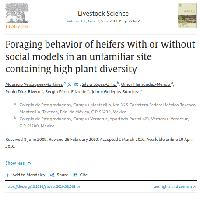Resumen
-
Grazing behavior, diet selection and weight gain of heifers (with or without social models) were assessed in an unfamiliar site containing high plant diversity. The study was performed within a tropical forest ecosystem containing a mixture of grass forb/herb, shrub and tree species. Ten inexperienced crossbred Bos taurus × Bos indicus heifers (7 ± 1 months old) were randomly assigned to one of two groups: naive or naive + social model (sm) and two experienced heifers (16 months old) were assigned to the second group. Naive heifers were bottle-nursed from days 2 to 90 after birth and began grazing at 1 month of age in tropical grass monocultures, while experienced animals had been foraging in sites containing a high diversity of plant species for 3 months prior to the study. Each group grazed in separate paddocks for a 12-week period during the rainy season, and animals were observed using focal sampling from 7:00 to 19:30 h to assess diet composition based on bite counts. Weight gain was assessed every 14 days. Paddocks contained from 1481 to 1789 kg/ha of herbaceous dry matter, enough to support the heifers throughout the study without affecting diet selection. Shrub and tree cover ranged from 55.2 to 58.4% across treatments. Bites per minute were adjusted to a log-scaled quadratic-plateau model and the curves showed no differences between treatments (P = 0.756). However, diet composition differed between groups (P < 0.001), with naive + sm heifers ingesting a greater proportion of trees (P < 0.001) and shrubs (P = 0.02), while naive heifers ingested more forb/herbs (P = 0.02); no difference in grass consumption was observed (P = 0.92). Heifers in both treatments consumed the same plant species (50 from 26 families). Over time, utilization of several plant species increased or decreased (P < 0.05), eventually leveling off for the remainder of the study. Although differences in diet composition were observed, they did not affect overall weight gain (117 and 113 g/day in the naive and naive + sm groups, respectively; P = 0.913). However, initial post-weaning weight loss was avoided in the naive + sm group. Social learning facilitates a higher use of shrubs and trees in tropical pastures containing a high diversity of plant species with different growth habits. As many plant species have high potential as forage, more effort should be placed on developing mechanisms to increase their dietary inclusion by cattle.
